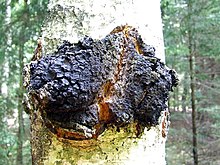| Inonotus obliquus | |
|---|---|

| |
| Scientific classification | |
| Domain: | Eukaryota |
| Kingdom: | Fungi |
| Division: | Basidiomycota |
| Class: | Agaricomycetes |
| Order: | Hymenochaetales |
| Family: | Hymenochaetaceae |
| Genus: | Inonotus |
| Species: | I. obliquus
|
| Binomial name | |
| Inonotus obliquus | |
| Synonyms[1] | |
|
Boletus obliquus Ach. ex Pers. (1801) | |
Inonotus obliquus, commonly called chaga (/ˈtʃɑːɡə/; a Latinisation of the Russian word чага), is a fungus in the family Hymenochaetaceae. It is parasitic on birch and other trees. The sterile conk is irregularly formed and resembles burnt charcoal. It is not the fruiting body of the fungus, but a sclerotium or mass of mycelium, mostly black because of a substantial amount of melanin.[2][3]
- ^ "Inonotus obliquus (Ach. ex Pers.) Pilát 1942". MycoBank. International Mycological Association. Retrieved 11 October 2011.
- ^ Babitskaya, VG; Shcherba, VV; Lkonnikova, NV (2000). "Melanin complex of the fungus Inonotus obliquus". Appl Biochem Microbiol. 36 (4): 377–381. doi:10.1007/BF02738046. S2CID 46047121.
- ^ Meuninck, Jim (2017). Foraging Mushrooms Oregon: Finding, Identifying, and Preparing Edible Wild Mushrooms. Falcon Guides. p. 111. ISBN 978-1-4930-2669-2.